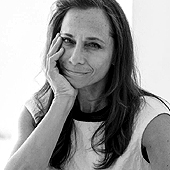
January 3, 2008
Remembering Paul Rand
My graduate thesis at Yale was a long, dissertation-style treatise on the history of the square. Only one member of the graduate faculty actually took the time to read it — and that was Paul Rand.
“With what little time I’ve had to read Jessica’s thesis, I have to conclude that the quality of the content deserves commendation,” he wrote in my written review. “But it looks like you designed it in three days,” he told me later. “It looks,” he said, staring straight at me to make sure I got the message, “like a piece of crap.”
Naturally, he was right: about the designing it in three days part, anyway. (Crap, I would later learn, is in the eye of the beholder.) But by then, I’d come to expect these sort of no-nonsense pronouncements from my thesis advisor. “The development of new typefaces is a barometer of the stupidity of our profession!” “Graphic design is not surgery!” Rand was irascible, unforgiving and impossible. Exalted standards of excellence were a point of pride with him. He loved form, hated market research, and fervently believed in the power of good design. He didn’t suffer fools — or anyone for that matter — gladly.
Periodically, I would visit him at his home in Weston, Connecticut, where we would sit at his kitchen table and talk. As we talked, he would think of books he wanted me to read, and he would go and fetch them, often sending me home with duplicate copies of his favorites — many of them on architecture, philosophy, art, even Judaica. I was the only Jewish girl in our class, and when he wasn’t playing the tough guy in the studio at school, he treated my like a granddaughter, even down to administering just the right dose of guilt. “You disappeared like a phantom!” he wrote me in a letter when I’d failed to visit him for a month or two. Like both of my grandfathers, Rand was at once paternal and taciturn, deeply principled and given to great, gusty bouts of laughter at the slightest provocation. I’d bring him chocolates. He’d make me tea. We’d sit for hours and argue. I loved every minute of it.
I don’t remember talking about design so much as just talking — about life, about ideas, about reading. “You will learn most things by looking,” he would say, “but reading gives understanding. Reading will make you free.” Once, he complained about the inadequacy of a text he wanted to assign the students, faulting his then-current translation of Le Corbusier and Ozenfant’s essay, “On The Plastic In Art” from 1922. He knew I’d been raised in France and asked me to provide a better translation for him, which I did. And he knew enough French to know mine was, at least for his purposes, the better version: not because I was a better translator, but because by that time, under his tutelage, I’d become a more observant student of design. And it was this, more than anything, that I learned from him: how to really look — deeply, ruthlessly, penetratingly — and see.
Years later, after I was married, I happened to be in Philadelphia with my husband when Mr. Rand was in town to give a lecture. Now frail and in his early 80s, we arranged to pick him up and deliver him back to his hotel at the end of the evening. As we helped him out of the taxi, he stopped, put his arm around me — we were the same exact height — and gave me a squeeze. Then he turned sternly to Bill. “You know, I’m not at all sure you’re good enough for her,” he barked. “But you’ll do.”
I felt so relieved and grateful that he chose, in what would be our last conversation, to critique my husband — and not my thesis.
This essay is taken from Michael Kroeger’s book, Paul Rand: Conversations with Students, which will be published on January 3 by Princeton Architectural Press and is reprinted here with kind permission from the publisher.
Observed
View all
Observed
By Jessica Helfand
Related Posts

Arts + Culture
Nila Rezaei|Essays
“Dear mother, I made us a seat”: a Mother’s Day tribute to the women of Iran

The Observatory
Ellen McGirt|Books
Parable of the Redesigner

Arts + Culture
Jessica Helfand|Essays
Véronique Vienne : A Remembrance

Design As
Lee Moreau|Audio
Announcing: Design As Season Two
Recent Posts
“Dear mother, I made us a seat”: a Mother’s Day tribute to the women of Iran A quieter place: Sound designer Eddie Gandelman on composing a future that allows us to hear ourselves think It’s Not Easy Bein’ Green: ‘Wicked’ spells for struggle and solidarity Making Space: Jon M. Chu on Designing Your Own PathRelated Posts

Arts + Culture
Nila Rezaei|Essays
“Dear mother, I made us a seat”: a Mother’s Day tribute to the women of Iran

The Observatory
Ellen McGirt|Books
Parable of the Redesigner

Arts + Culture
Jessica Helfand|Essays
Véronique Vienne : A Remembrance

Design As
Lee Moreau|Audio

 Jessica Helfand, a founding editor of Design Observer, is an award-winning graphic designer and writer and a former contributing editor and columnist for Print, Communications Arts and Eye magazines. A member of the Alliance Graphique Internationale and a recent laureate of the Art Director’s Hall of Fame, Helfand received her B.A. and her M.F.A. from Yale University where she has taught since 1994.
Jessica Helfand, a founding editor of Design Observer, is an award-winning graphic designer and writer and a former contributing editor and columnist for Print, Communications Arts and Eye magazines. A member of the Alliance Graphique Internationale and a recent laureate of the Art Director’s Hall of Fame, Helfand received her B.A. and her M.F.A. from Yale University where she has taught since 1994.